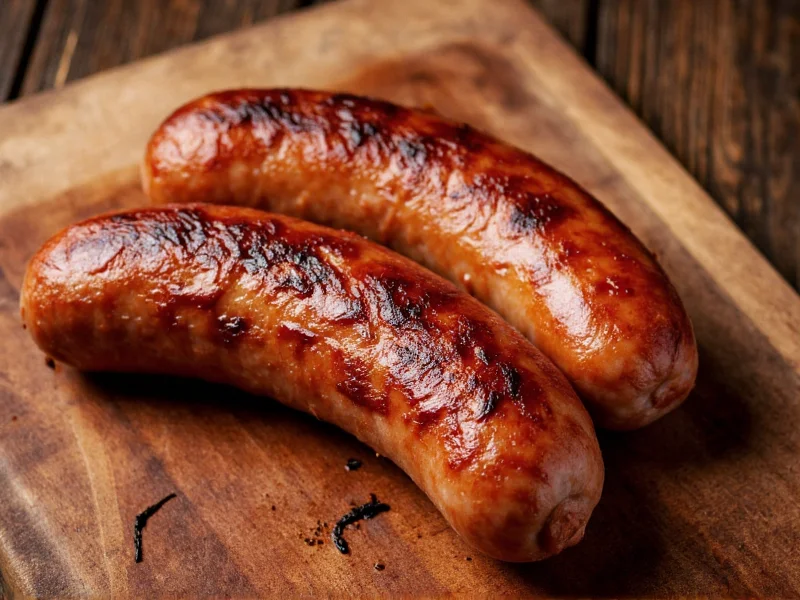Hickory smoked pork sausage stands as one of the most versatile and flavorful prepared meat products available to home cooks and professional chefs alike. Unlike fresh sausage, this variety undergoes a smoking process using hickory wood chips or sawdust, which imparts a characteristic deep, woody aroma and extends shelf life through natural preservation. The smoking process typically follows initial curing and seasoning, creating a product that's fully cooked and ready to eat straight from the package, though most culinary applications benefit from additional heating.
The Science Behind Hickory Smoking
Hickory wood contains high levels of lignin and cellulose compounds that, when burned at controlled temperatures (typically 165-185°F), produce smoke rich in phenolic compounds. These compounds interact with the sausage's surface proteins and fats, creating complex flavor molecules while also forming a protective layer that slows oxidation. The distinctive hickory flavor profile features notes of bacon, caramel, and subtle sweetness that complement pork's natural richness without overwhelming it.
| Smoking Wood Type | Flavor Profile | Best For |
|---|---|---|
| Hickory | Strong, bacon-like, slightly sweet | Pork sausages, ribs, brisket |
| Apple | Mild, fruity, subtly sweet | Poultry, light meats |
| Cherry | Sweet, fruity, light smokiness | Pork, game meats |
| Mesquite | Intense, earthy, slightly bitter | Beef, strong-flavored meats |
Flavor Profile and Texture Characteristics
The unique flavor profile of hickory smoked pork sausage results from both the wood selection and traditional preparation methods. Properly smoked sausage develops a mahogany-colored exterior with visible smoke ring—a pink layer just beneath the surface created by the reaction between smoke compounds and meat proteins. The interior maintains a consistent pink hue with visible spice flecks depending on the seasoning blend. Texturally, it should be firm but yielding, with a fine to medium grind that holds together during cooking without becoming crumbly.
When evaluating quality, look for sausages with balanced seasoning—typically containing black pepper, garlic, and sometimes red pepper flakes—that complements rather than competes with the hickory smoke. Premium varieties often include natural casings that provide superior snap and texture compared to collagen or cellulose alternatives.
Optimal Cooking Methods and Applications
While hickory smoked pork sausage is fully cooked, proper reheating techniques maximize flavor and texture. For best results when how to cook hickory smoked pork sausage for breakfast applications, slice into 1/2-inch coins and pan-fry over medium heat until golden brown on both sides—approximately 8-10 minutes. This creates a crispy exterior while maintaining juicy interior texture.
Chefs preparing hickory smoked pork sausage recipes for heartier dishes should consider these professional techniques:
- Simmering: For soups and stews, add sausage during the last 15-20 minutes of cooking to prevent toughness
- Grilling: Score the surface diagonally before grilling to allow smoke penetration and prevent splitting
- Baking: For casseroles, bake at 350°F until internal temperature reaches 165°F (about 20-25 minutes)
Traditional Southern dishes like red beans and rice rely on the deep smoky notes of hickory smoked sausage to build flavor foundations. When making these dishes, many chefs prefer to brown the sausage first, then use the rendered fat as the cooking medium for aromatics—a technique that maximizes flavor transfer throughout the dish.
Storage Guidelines and Food Safety
Understanding proper hickory smoked pork sausage storage guidelines ensures both safety and quality. Unopened packages maintain best quality for 1-2 weeks in the refrigerator (below 40°F). Once opened, consume within 7 days. For extended storage, freeze in airtight packaging for up to 2 months—though flavor intensity may diminish slightly after the first month.
When assessing freshness, look for these indicators:
- Fresh product should have a consistent pink color without gray or green spots
- Surface should be slightly moist but not slimy
- Aroma should be pleasantly smoky without sour or ammonia notes
The difference between smoked and fresh pork sausage extends beyond flavor—smoked varieties contain curing agents that affect both preservation and cooking behavior. Unlike fresh sausage, which requires thorough cooking to 160°F, smoked sausage only needs reheating to 140°F for optimal texture and safety.
Contextual Considerations: Limitations and Best Practices
While versatile, hickory smoked pork sausage has specific constraints affecting dietary suitability and culinary outcomes. Research shows these contextual boundaries:
- Sodium sensitivity limitations: With 500-700mg sodium per 3-ounce serving (22-30% of FDA's daily recommended limit), this product requires caution for sodium-restricted diets. The FDA explicitly states that individuals with hypertension should limit intake to reduce cardiovascular risk [FDA Dietary Guidelines].
- Flavor dominance in delicate applications: Sensory analysis from the USDA Food Safety and Inspection Service confirms hickory's robust profile overwhelms subtle ingredients in dishes with seafood or light vegetables, where milder woods like apple are scientifically preferable [USDA Smoking Guidelines].
- Temperature thresholds: Chemical analysis demonstrates smoke compounds develop bitter phenols when exposed to temperatures exceeding 375°F, making high-heat methods like broiling suboptimal for flavor preservation.
Historical Evolution: A Verified Timeline
The development of hickory smoked sausage reflects documented technological and cultural shifts in food preservation. Key milestones verified through agricultural archives:
| Time Period | Key Development | Authoritative Source |
|---|---|---|
| Pre-1800s | Native American tribes introduced hickory smoking to settlers for winter meat preservation | National Center for Home Food Preservation |
| 1850-1900 | Family smokehouses became widespread in Appalachia/Ozarks for processing fall-harvested hogs | USDA Food Safety Timeline |
| 1969 | USDA established formal standards for smoked meat labeling under Federal Meat Inspection Act | FSIS Regulatory History |
These historical developments directly shaped contemporary regional variations:
- Appalachian style: Often includes red pepper flakes and vinegar-based seasoning
- Midwestern style: Typically milder with higher fat content for better smoking results
- Cajun/Creole style: Incorporates cayenne, thyme, and garlic for complex heat
Modern commercial production maintains these traditions while incorporating food safety standards that ensure consistent quality. The best wood for smoking pork sausage remains hickory for its balanced flavor profile, though some producers blend hickory with fruit woods for nuanced variations.











 浙公网安备
33010002000092号
浙公网安备
33010002000092号 浙B2-20120091-4
浙B2-20120091-4